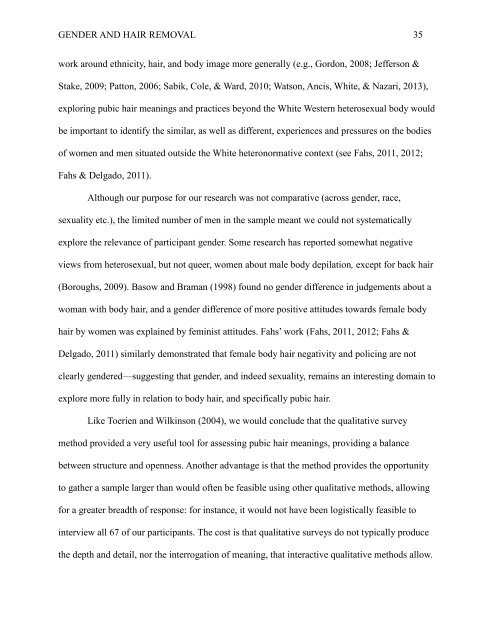Braun, V. , Tricklebank, G. and Clarke, V. (2013) It shouldnt stick out ...
Braun, V. , Tricklebank, G. and Clarke, V. (2013) It shouldnt stick out ...
Braun, V. , Tricklebank, G. and Clarke, V. (2013) It shouldnt stick out ...
You also want an ePaper? Increase the reach of your titles
YUMPU automatically turns print PDFs into web optimized ePapers that Google loves.
GENDER AND HAIR REMOVAL 35<br />
work around ethnicity, hair, <strong>and</strong> body image more generally (e.g., Gordon, 2008; Jefferson &<br />
Stake, 2009; Patton, 2006; Sabik, Cole, & Ward, 2010; Watson, Ancis, White, & Nazari, <strong>2013</strong>),<br />
exploring pubic hair meanings <strong>and</strong> practices beyond the White Western heterosexual body would<br />
be important to identify the similar, as well as different, experiences <strong>and</strong> pressures on the bodies<br />
of women <strong>and</strong> men situated <strong>out</strong>side the White heteronormative context (see Fahs, 2011, 2012;<br />
Fahs & Delgado, 2011).<br />
Although our purpose for our research was not comparative (across gender, race,<br />
sexuality etc.), the limited number of men in the sample meant we could not systematically<br />
explore the relevance of participant gender. Some research has reported somewhat negative<br />
views from heterosexual, but not queer, women ab<strong>out</strong> male body depilation, except for back hair<br />
(Boroughs, 2009). Basow <strong>and</strong> Braman (1998) found no gender difference in judgements ab<strong>out</strong> a<br />
woman with body hair, <strong>and</strong> a gender difference of more positive attitudes towards female body<br />
hair by women was explained by feminist attitudes. Fahs’ work (Fahs, 2011, 2012; Fahs &<br />
Delgado, 2011) similarly demonstrated that female body hair negativity <strong>and</strong> policing are not<br />
clearly gendered—suggesting that gender, <strong>and</strong> indeed sexuality, remains an interesting domain to<br />
explore more fully in relation to body hair, <strong>and</strong> specifically pubic hair.<br />
Like Toerien <strong>and</strong> Wilkinson (2004), we would conclude that the qualitative survey<br />
method provided a very useful tool for assessing pubic hair meanings, providing a balance<br />
between structure <strong>and</strong> openness. Another advantage is that the method provides the opportunity<br />
to gather a sample larger than would often be feasible using other qualitative methods, allowing<br />
for a greater breadth of response: for instance, it would not have been logistically feasible to<br />
interview all 67 of our participants. The cost is that qualitative surveys do not typically produce<br />
the depth <strong>and</strong> detail, nor the interrogation of meaning, that interactive qualitative methods allow.

















